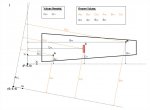I have a problem involving 2 axis systems for the same area.
I have the location of 2 points in both axes and the location of a third point in only 1 axis.
With the objective being to calculate the coordinates for the third point in the other axis.
The diagram (jpg attachment) I put together explains it much more clearly.
Been trying to get starting figuring I need to work out the angle between the axes and the difference in origin location, but it's been so long since I did any of this I'm getting stumped:
I have the location of 2 points in both axes and the location of a third point in only 1 axis.
With the objective being to calculate the coordinates for the third point in the other axis.
The diagram (jpg attachment) I put together explains it much more clearly.
Been trying to get starting figuring I need to work out the angle between the axes and the difference in origin location, but it's been so long since I did any of this I'm getting stumped:
Attachments
Last edited:


